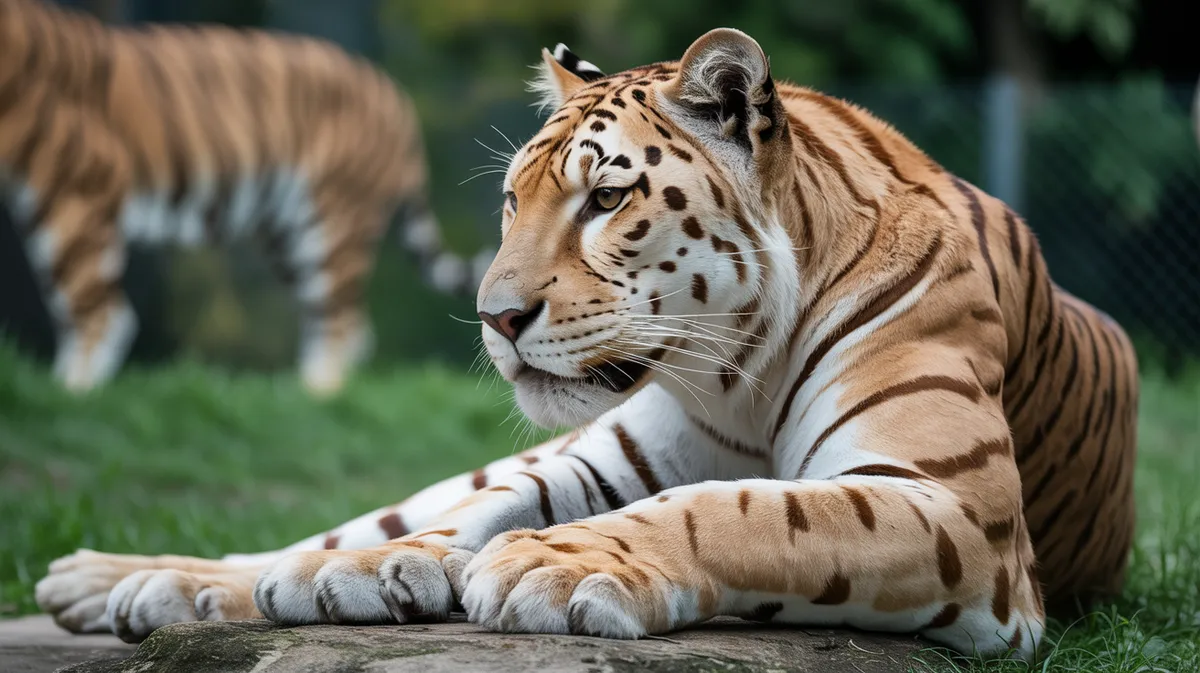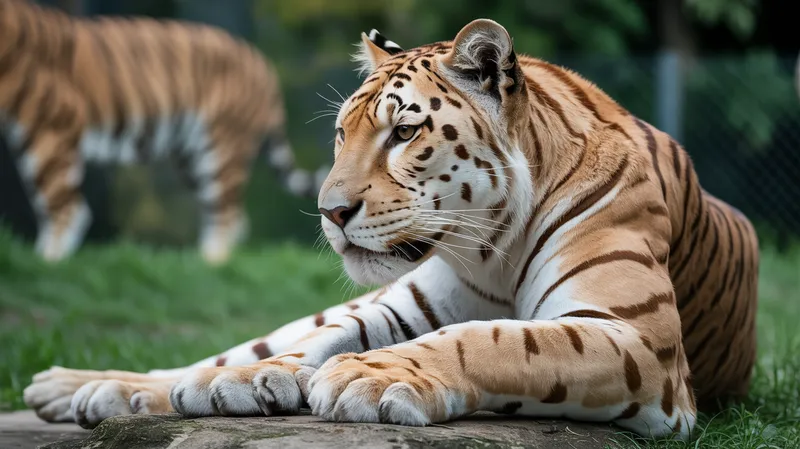
Liger
Panthera leo × Panthera tigris

Meet the Liger
The liger is a hybrid big cat resulting from the crossbreeding of a male lion (Panthera leo) and a female tiger (Panthera tigris). Ligers are the largest known cats in the world, often surpassing both parent species in size and weight. They are not found in the wild, as their parents' natural ranges do not overlap, and are typically bred in captivity. Ligers display a blend of physical and behavioral traits from both lions and tigers, such as faint tiger stripes and the sociability of lions. Their existence is controversial due to ethical and health concerns associated with hybridization.
Classification
Mammal
Habitat
Captivity
Diet
Carnivore
Lifespan
12-20 years
Conservation
Not Evaluated
Weight
320-450 kg (705-990 lbs)
📖Fascinating Facts
Record Size
The largest living liger, named Hercules, weighs over 418 kg (922 lbs) and holds the Guinness World Record for the biggest living cat.
Hybrid Parentage
Ligers result exclusively from the mating of a male lion and a female tiger, while a tigon comes from a male tiger and a female lion.
Swimming Ability
Unlike lions, which typically avoid water, many ligers enjoy swimming, similar to their tiger relatives.
📋Detailed Description
The liger (Panthera leo × Panthera tigris) is the hybrid offspring of a male lion and a female tiger, resulting in the largest extant felid known to science. Adult male ligers can reach lengths of up to 3.6 meters (12 feet) including the tail, and can weigh between 350–450 kg (770–990 lbs), with some exceptional individuals reportedly exceeding 500 kg (1,100 lbs). Their appearance is a blend of both parent species: they typically exhibit a tawny or golden coat with faint, pale tiger-like stripes and, in males, a modest mane that is less developed than that of a pure lion. Ligers have robust, muscular bodies, large heads, and powerful limbs, reflecting their hybrid vigor. Their skull morphology is intermediate between lions and tigers, with broad zygomatic arches and pronounced sagittal crests. Behaviorally, ligers combine the sociability of lions with the affinity for water and swimming characteristic of tigers. They are known for their gentle disposition in captivity, though they retain the predatory instincts of both parents. Ligers are exclusively found in captivity, as the natural ranges of lions and tigers do not overlap in the wild, and intentional breeding is required. Their hybrid status often results in health complications, such as joint disorders, organ dysfunction, and reduced fertility, particularly in males. Despite these challenges, ligers can live up to 15–20 years in managed care, similar to their parent species.
💡 Did you know?
Ligers are sterile in most cases, which means they cannot reproduce naturally.
🔬Research & Sources
Wikipedia Summary
The liger is a hybrid offspring of a male lion and a tigress, or female tiger. The liger has parents in the same genus but of different species. The liger is distinct from the opposite hybrid called the tigon, and is the largest of all known extant felids. They enjoy swimming, which is a characteristic of tigers, and are very sociable like lions. Notably, ligers typically grow larger than either parent species, unlike tigons.
Last Modified: 4/16/2025
🎭Behavior & Social Structure
Ligers display a unique mix of behavioral traits inherited from both lions and tigers. They are generally more sociable than tigers, often enjoying the company of other big cats and humans, a trait inherited from lions' pride-based social structure. Ligers are also highly playful and interactive, especially when young. Unlike most lions, ligers are strong swimmers and frequently seek out water to bathe or play, reflecting their maternal tiger lineage. Their feeding behavior is characterized by a voracious appetite; adult ligers may consume up to 13–15 kg (29–33 lbs) of meat per day. In captivity, they are fed a diet of beef, chicken, and sometimes supplemented with vitamins and minerals. Ligers are crepuscular, being most active during dawn and dusk, and spend much of their day resting or lounging. They exhibit territorial behaviors, such as scent marking, but are less aggressive than wild lions or tigers. Hunting instincts are present, but in captivity, their opportunities for predatory behavior are limited to enrichment activities.
👶Reproduction & Life Cycle
Ligers are the result of deliberate crossbreeding between a male lion and a female tiger, as natural hybridization does not occur in the wild. Female ligers are often fertile and can reproduce with lions, tigers, or other ligers, whereas male ligers are typically sterile due to hybrid incompatibility (a phenomenon consistent with Haldane's Rule). The gestation period for a liger is approximately 100–110 days, similar to both parent species. Litter sizes range from 2 to 4 cubs, though cub mortality is high due to genetic complications and developmental issues. Maternal care is provided by the tigress, who nurses and protects the cubs for the first few months. Breeding ligers raises significant ethical concerns due to the increased risk of birth defects, health problems, and the lack of conservation value, as ligers do not contribute to the survival of either parent species.
🛡️Adaptations & Survival
Ligers exhibit hybrid vigor, or heterosis, which often results in greater size and growth rates compared to both parent species. This gigantism is believed to result from the absence of certain growth-inhibiting genes that are species-specific, particularly those related to genomic imprinting. Physically, ligers possess powerful jaws, robust musculature, and large paws, making them formidable animals. Their semi-retractable claws and acute senses of sight, smell, and hearing are inherited from both lions and tigers. Behaviorally, their sociability and affinity for water are adaptive traits from their respective parents. However, ligers lack evolutionary adaptations for survival in the wild, as they are not a naturally occurring species and are not equipped to establish territories, hunt, or reproduce successfully outside of captivity.
📚Research Sources
🎨Cultural Significance
Ligers have captured public imagination due to their impressive size and rarity, often featured in zoos, wildlife parks, and popular media. They have been referenced in literature, film, and internet culture, most notably in the 2004 film 'Napoleon Dynamite.' Historically, hybrid big cats were exhibited in menageries and circuses as curiosities. However, ligers hold no traditional or mythological significance in the cultures native to lions or tigers, as their parent species do not coexist in the wild. In modern times, they have become symbols in debates about animal ethics, conservation priorities, and the consequences of human intervention in wildlife genetics.
🔬Recent Research & Discoveries
Recent scientific studies on ligers have focused on the genetic and physiological mechanisms underlying their exceptional growth, particularly the role of genomic imprinting and growth hormone regulation. Research has also examined the health and welfare of hybrid big cats, highlighting the increased risk of congenital defects and the importance of ethical breeding practices. Ongoing studies in comparative genomics aim to better understand hybridization barriers and fertility in Panthera species. Veterinary research has provided insights into the management of obesity, joint health, and enrichment for ligers in captivity. There is growing consensus among conservation biologists that resources should be directed toward the preservation of wild lion and tiger populations rather than the propagation of hybrids.
🎥Wildlife Videos

Lions, Tigers and Ligers! | World's Weirdest
#NatGeoWILD #WorldsWeirdest #Ligers About World's Weirdest: A buffalo with three eyes, an exterminator who eats his day's ...
Nat Geo Animals

Could Ligers Survive in The Wild?
Could Ligers Survive in The Wild? ➤ Please consider to SUBSCRIBE: ...
WildCiencias

Liger - The Biggest and Strongest Feline in the World
Liger - The Biggest and Strongest Feline in the World We have all heard of tigers and lions. But how about a combination between ...
WildFacts

Liger | The Largest Cat in the World. Amazing facts about Ligers. Most Powerful Big Cat
The Liger is a hybrid. It is the offspring of a male Lion and a female Tiger. This means that the Liger has parents that are different ...
KiloFact - Interesting Facts

Incredible Hybrid Animals - Wholphins, Grolar Bears, Ligers and More
In this video, we're looking at interesting hybrids from around the world. 1. Ligers/Tigons 2. New Hybrid Shark Species 3. Grolar ...
All.About.Nature

The sad Reality Behind Ligers #animals #liger #shorts
Loy Hasychak
🌍Habitat Information
The Liger typically inhabits Captivity environments. Ligers have adapted to their environments with specialized features and behaviors.
Primary Habitat:
Captivity
More detailed habitat information will be available soon.
🛡️Conservation Status
The Liger is currently classified as Not Evaluated. Conservation efforts are crucial for preserving this species for future generations.
Common Threats:
- 🏠Habitat loss and fragmentation
- 🌡️Climate change impacts
- 🎯Hunting and poaching
- 🏭Human-wildlife conflict
⚠️Threats & Conservation Challenges
Ligers face numerous health challenges due to their hybrid status, including joint and skeletal disorders, organ dysfunction, neurological issues, and a predisposition to obesity. Their large size can lead to mobility problems and shortened lifespans if not carefully managed. Ethical concerns regarding their breeding include animal welfare issues, lack of conservation value, and the potential for exploitation in entertainment or private collections. There is no wild population of ligers, and their existence is entirely dependent on human intervention. Regulatory oversight varies by country, with some jurisdictions banning or restricting the breeding of hybrid big cats. Public awareness and animal welfare advocacy have led to increased scrutiny of facilities that breed ligers, emphasizing the need for responsible management and the prioritization of conservation efforts for purebred lions and tigers.
🔬Scientific Classification
Scientific Name
Panthera leo × Panthera tigris
Classification Hierarchy
🔍 About Taxonomic Classification
Taxonomic classification is a hierarchical system used by scientists to classify and organize living organisms based on shared characteristics and evolutionary relationships.
The system moves from broad categories (Kingdom) to increasingly specific ones, with each animal's scientific name typically consisting of its Genus and species.
📝Community Notes
Share your observations and insights about the Liger with our community of wildlife enthusiasts.
Join Our Community
Sign in to share your observations and connect with fellow wildlife enthusiasts.
Sign In to ContributeNo community notes yet
Be the first to share your observations about the Liger!
Explore Liger
Select a tab above to learn more about this amazing animal.
📸Photo Gallery
No photos available for this animal yet.
🌟Discover More Wildlife
Continue your journey of discovery with more fascinating animals from our database
